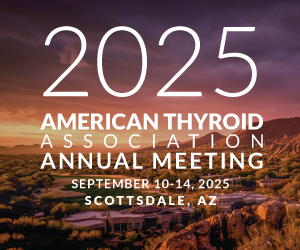December 13, 2006
The Centers for Disease Control and Prevention (CDC) has just published data on urinary perchlorate, nitrate, and thiocyanate levels that they have measured from a nationwide health survey conducted in 2001-2002 [NHANES 01-02](1). Their analysis has now been published in the journal Environmental Health Perspectives. The authors report that women with low urinary iodine spot measurement (< 100 ug/L) had lower levels of serum thyroxine and higher levels of TSH associated with higher levels of perchlorate in the urine, although these values remained within the normal range. Among the women with urinary iodine values > 100 ug/L, serum TSH, but not serum T4 values, were associated with urine perchlorate values. In contrast, there was no association between urinary perchlorate concentration and thyroid function tests in men, irrespective of iodine excretion. We understand that further analyses of these data will be conducted and that CDC intends to replicate it in a subsequent population study.
These findings are intriguing, although several features of the study may limit the immediate application to guidelines for perchlorate exposure standards. These additional factors need to be considered in order to interpret these analyses. Serum thyroxine was measured as total thyroxine rather than as free thyroxine, the most frequently used clinical measurement and the physiologically available form of thyroxine. Thyroid autoantibodies, an important confounder in thyroid physiology, have not yet been measured. These have an especially high prevalence in women and may have contributed to the reported correlations. The presence of potentially confounding pharmaceutical and medical factors, such as estrogen use or autoimmune thyroid disease, was not used as a basis for exclusion from the analysis. Inclusion of laboratory results from multiple laboratories may need to be more carefully considered. The reason that perchlorate, but no other measured goitrogen studied, influenced thyroid function at low urinary levels of iodine is not explained. The development of further laboratory information is necessary before the implications of the findings can be understood. The issues raised are important and additional study to resolve them should be pursued.
1. Blount BC, Pirkle JL, Osterloh JD, Valentin-Blasini L, Caldwell KL. Urinary perchlorate and thyroid hormone levels in adolescent and adult men and women living in the United States. Environmental Health Perspectives <doi:10.1289/ehp.9466 (available at http://dx.doi.org/) Online 5 October 2006>
For a complete background on this issue, please see on the ATA Website <www.thyroid.org>, “Question of Perchlorate Exposure and Potential Effects of the Thyroid”, posted February 3, 2004 and an update posted April 25, 2005 .
The American Thyroid Association (ATA) is the North American professional society for physicians and researchers specializing in diseases of the thyroid gland. The ATA promotes excellence and innovation in clinical care, research, education, and public advocacy.
# # #



